 HOME | INFO | NEWS | -> DOSSIER <- | BACHECA / TERMINE |
EDICOLA / KIOSK | LADIN
HOME | INFO | NEWS | -> DOSSIER <- | BACHECA / TERMINE |
EDICOLA / KIOSK | LADINBy Thomas Benedikter
Bolzano/Bozen, 20. March 2008
Content
Cases of open conflicts
1. The Cordillera Region (Philippines)
2. West Papua (Indonesia)
3. Western Balochistan (Iran)
4. The Chittagong Hill Tracts (Bangla Desh)
5. Transylvania (Romania)
6. Transnistria (Moldova)
7. South Ossetia (Georgia)
8. Cabinda (Angola)
9. Gilgit-Baltistan (Pakistan)
10. Jammu, Ladakh and the Valley of Kashmir (India)
11. Turkish Kurdistan
12. Corsica and Brittany (France)
13. Caracoles de Chiapas (Mexico)
14. Tibet
Territorial regional autonomy hitherto has been established in
at least 21 countries. As some states are home to more than one
autonomous region (Spain has 17 "Autonomous Communities", Italy 5
regions with special autonomy, Great Britain 3, Nicaragua and
Portugal 2 etc.), there are at least 60 regions in the world
vested with territorial autonomy defined along scientifically
based criteria. Territorial autonomy is successfully operating
since 1921, when the Aland Island obtained their special status
within Finland, while the most recent autonomy, namely that of
the Province of Aceh in Indonesia is about to be approved by the
Indonesian Parliament in June 2006. The basic features of these
working autonomies - at least one autonomous region for each of
the 21 countries - have been illustrated in "The World's Working
Regional Autonomies".
In the scientific literature there is still no comparative
empirical evaluation of the results produced by these specific
arrangements, following the model of comparative federal studies.
Yet, comparisons often are barred by the assumed "uniqueness" of
every autonomy system, and the same is said for attempts to
suggest solutions transferring certain models of autonomy
arrangements to other similar conflict areas. This is true, but
only partially: each working autonomy has been created against a
specific social, political, cultural, ethnic background, based on
unique historical and political genesis and aimed to accommodate
the needs and interests of specific groups living in those areas
and minority peoples within a state. But, on the other hand,
territorial autonomy is also a precisely definable relationship
between a central state and a region and all working autonomies
of the world share some basic features. As these features can be
evaluated distinctively and its results can be empirically
evaluated, assumptions can be made related to
- the general applicability of territorial autonomy in a given
political environment
- the possible basic features of a working autonomy in order to
achieve specific aims
- the transfer not of entire "models of autonomy systems", but of
single elements and regulations or a set of elements,
institutions and procedures which in various existing experiences
of autonomy have proved as rather efficient.
Of course, the conflict parties - state elites and regional
communities - starting from this assumption never are released of
the necessity to hammer out the specific design of an autonomy
suitable to solve a given conflict.
Starting from this general assumption it is possible to determine
a list of regions on all continents, afflicted by violent
conflicts, deep ethnic or religious cleavages, burdened by the
strain of discrimination and oppression of national minorities or
entire minority peoples (or colonised peoples) since decades (For
the currently ongoing wars see http://en.wikipedia.org/wiki/Ongoing_wars).
Figuring out an autonomy solution for such conflicts is not just
political science fiction or an academic game, but worth of
serious reflections about feasibility and international mediation
efforts, taking into consideration that territorial autonomy has
been mostly positive experience in about 60 regions all over the
world. The following list of 14 regions in conflict with the
central state has been compiled not arbitrarily out of a longer
list of the world's open conflicts, but according to three main
criteria:
1. territorial autonomy has already been envisaged as a possible
solution by the conflict parties, but not thoroughly implemented,
or autonomy has already been established in some other areas of
the same state;
2. external self-determination with subsequent secession, even if
legitimised under international law, seems to exacerbate the
internal conflict or be impossible by various serious political
factors;
3. the considered regions are all home to national minorities or
minority peoples, but often also multinational regions which
could turn into interethnic violence again if secession
occurred.
As several examples show territorial autonomy can be established
also within federal states where the basic challenge consists in
adapting the vertical power sharing within a single federated
state (e.g. India or Mexico) in order to accommodate the interest
of minorities or regions with special needs. The list is far from
being complete, but can serve to underscore the urgent need to
promote territorial autonomy solutions for open ethnic conflicts.
Moreover, if autonomy could be enshrined not only in
constitutions, but in international covenants this would provide
the autonomous regions on the one hand a safe entrenchment, the
state parties at the other hand would be reassured that autonomy
would not enhance secession. This issue will be briefly
highlighted in chapter 2 of this essay.
While some self-determination conflicts, such as Palestine, Western Sahara, Sri Lanka, Cyprus, Myanmar, and Somalia can be hardly imagined to be solved through autonomy arrangements alone, the case is different for a major group of regional conflicts in several conflicts. Some of these conflicts are smouldering since many years leading to structural discrimination, social tensions, cultural oppression (political exclusion). Some of them are a continuous source for violent confrontation and military action an reaction, as confirmed by the current list of ongoing conflicts. In the following 14 examples.
 http://en.wikipedia.org/wiki/Cordillera_Administrative_Region.
The Gran Cordillera is the largest mountain range of the
Philippines, covering 1/6 of the Luzon island (about 18.300 km2).
The population of about 1,1 million (2% of the Philippines' total
population) is formed mainly by Igorots ("people from the
mountains"). The area is divided in 5 provinces, namely
Kalinga-Apoyo, Abra, Ifugao, Benquet and Mountain Province. The
peoples of the Cordillera are represented by the CPA (Cordillera
People's Alliance), the federation of political forces and civil
organisations of the indigenous peoples of the region, founded in
1984 by seven Igorot organisations and today consisting of more
than 120 member organisations. Beyond the peaceful struggle for
autonomy, the Cordillera People's Liberation Army started
guerrilla war in the first 80s, later continued by the communist
"New People's Army" (NPA).
http://en.wikipedia.org/wiki/Cordillera_Administrative_Region.
The Gran Cordillera is the largest mountain range of the
Philippines, covering 1/6 of the Luzon island (about 18.300 km2).
The population of about 1,1 million (2% of the Philippines' total
population) is formed mainly by Igorots ("people from the
mountains"). The area is divided in 5 provinces, namely
Kalinga-Apoyo, Abra, Ifugao, Benquet and Mountain Province. The
peoples of the Cordillera are represented by the CPA (Cordillera
People's Alliance), the federation of political forces and civil
organisations of the indigenous peoples of the region, founded in
1984 by seven Igorot organisations and today consisting of more
than 120 member organisations. Beyond the peaceful struggle for
autonomy, the Cordillera People's Liberation Army started
guerrilla war in the first 80s, later continued by the communist
"New People's Army" (NPA).
Until now not more than a "Cordillera Administrative Region" has
been established. But the Cordillera Peoples Alliance is seeking
the institution of a genuine autonomy with a "Cordillera Regional
Assembly", a "Cordillera executive board" and the "Cordillera
Bodong Administration" as transitory bodies. Genuine autonomy
could be a realistic compromise solution as the Philippines
already are engaged in talks about such a scheme and the
government has already established autonomy in 1990 on Mindanao
for the Islamic Moro population.
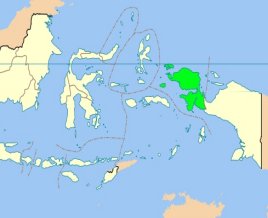 http://en.wikipedia.org/wiki/West_Papua_%28province%29.
The island of Papua Niugini is home to about a thousand of
different indigenous peoples of Melanesian provenience. West
Papua hosts the world's highest ethnic diversity on one
territory. Since 1848 the island was divided between colonial
powers (Great Britain, Netherlands, and Germany). When in 1949
Indonesia gained full independence from the Netherlands, it
claimed West Papua too, but did not occupy it. While Australia
and the Netherlands prepared West Papua's independence and in
1962 handed the territory over to a United Nations interim
administration. Soon after 1962 Indonesia invaded the peninsula
and on 1 May 1963 became the new colonial power. No possibility
of referendum was given to the population of West Papua. Ever
since revolts and resistance have been repressed by Indonesia.
The West Papuan indigenous population (about 900.000 people) have
recently been outnumbered by about one million of Indonesian
settlers, supported by the state authorities and its
"transmigrasi"-program. The indigenous OPM resistance movement is
continuing its armed resistance.
http://en.wikipedia.org/wiki/West_Papua_%28province%29.
The island of Papua Niugini is home to about a thousand of
different indigenous peoples of Melanesian provenience. West
Papua hosts the world's highest ethnic diversity on one
territory. Since 1848 the island was divided between colonial
powers (Great Britain, Netherlands, and Germany). When in 1949
Indonesia gained full independence from the Netherlands, it
claimed West Papua too, but did not occupy it. While Australia
and the Netherlands prepared West Papua's independence and in
1962 handed the territory over to a United Nations interim
administration. Soon after 1962 Indonesia invaded the peninsula
and on 1 May 1963 became the new colonial power. No possibility
of referendum was given to the population of West Papua. Ever
since revolts and resistance have been repressed by Indonesia.
The West Papuan indigenous population (about 900.000 people) have
recently been outnumbered by about one million of Indonesian
settlers, supported by the state authorities and its
"transmigrasi"-program. The indigenous OPM resistance movement is
continuing its armed resistance.
In 2001 an autonomy package was granted to West Papua by the
government in Jakarta, but its main pillar, the "Papuan People's
Council" yet doesn't operate since West Papua has been divided
into two provinces. The indigenous peoples see the major threats
in the large migration from other Indonesian islands and the
exploitation of Papua's natural resources. If the MRP (Majelis
Rakyat Papua) would collapse, no genuinely representative
dialogue partner with Jakarta wouldn't any more exist. Jakarta
carved out West Irian Jaya as a separate province without
autonomy from the Western part of the island. Autonomy for the
whole region could be envisaged also following the successful
compromise solution achieved on 15 August 2005 in Aceh, which led
to a genuine territorial autonomy in 2006.
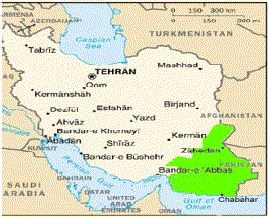 http://en.wikipedia.org/wiki/Balochistan_%28Iran%29.
Historical Balochistan is comprising a land area of nearly
700.000 km2, divided between Iran (280.000 km2), Pakistan
(350.000 km2) and the rest in southern Afghanistan. Of its total
population of 13 to 15 million about 4 million are living in
Iran, who do not enjoy even limited cultural or political
autonomy. The Baloch speak two distinct Indo-European languages,
Baloch and Brahui. The majority are Sunni Muslims.
http://en.wikipedia.org/wiki/Balochistan_%28Iran%29.
Historical Balochistan is comprising a land area of nearly
700.000 km2, divided between Iran (280.000 km2), Pakistan
(350.000 km2) and the rest in southern Afghanistan. Of its total
population of 13 to 15 million about 4 million are living in
Iran, who do not enjoy even limited cultural or political
autonomy. The Baloch speak two distinct Indo-European languages,
Baloch and Brahui. The majority are Sunni Muslims.
Western Balochistan was annexed to Persia in 1928. The Baloch
under Iran never have been recognised as a distinct people or
national minority and even denied any cultural rights. Political
Baloch organisations have been banned and forcedly dismantled.
Political freedom in West Balochistan is inexistent. In 2003 the
Balochistan People's Party (BPP) has been founded aiming to give
voice to the Baloch grievances. Autonomy is one of the possible
conflict solutions envisaged by the BPP. Fundamental rights and
autonomy rights of the Baloch population are violated also in the
Pakistani part of Eastern Balochistan. A similar conflict
scenario within Iran is given in the Region of Ahwaz, inhabited
mostly by ethnic Arabs.
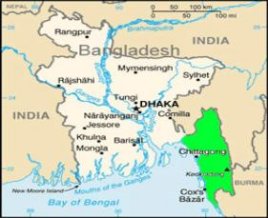 http://en.wikipedia.org/wiki/Chittagong.
The Chittagong Hill Tracts (CHT) comprise an area of 13.180 km2
in South Eastern Bangla Desh bordering to India and Myanmar
(Burma). The indigenous population of at least 1,1 million belong
to different tribal groups.
http://en.wikipedia.org/wiki/Chittagong.
The Chittagong Hill Tracts (CHT) comprise an area of 13.180 km2
in South Eastern Bangla Desh bordering to India and Myanmar
(Burma). The indigenous population of at least 1,1 million belong
to different tribal groups.
Most are Buddhist, some Christians and animists. The major ethnic
groups among 13 peoples are the Chakma, Tipra, Murong and Magh,
but almost 50% of the present day's population are immigrated
Bengali Muslim settlers. Since the independence of Bangla Desh
the indigenous population was faced with increasing immigration
of settlers from the mainland, fostered by the central
government. Among the tribal nations first political and civil,
later (since the 80s) armed resistance was organised, especially
by the Shanti Bahini guerrilla movement. In reaction the whole
region was heavily militarised and the police and army unleashed
a wide spread repression with a serious human rights violations.
The 5-points-manifesto of the Jana Samhati Samiti, released on 7
September 1987, was focused on a well entrenched autonomy:
1. autonomy for the CHT with legislative assembly and recognition
of the right to self-determination
2. inclusion of this provision in the Constitution
3. removal of all non-tribals settled in CHT after 17 August
1947
4. allocation of funds from the government to develop the
region
5. creation of favourable environment for a political solution of
the crisis.
On 2 December 1997 a "Peace agreement" was signed by the
government and Parvatya Chattagram Jana Samhati Samiti, the
political platform of the indigenous peoples, granting a limited
level of autonomy to three districts of CHT. The Jana Samhati
Samiti transformed into a party, but this treaty has never been
implemented, as it was opposed by both the opposition parties of
Bangla Desh and by the majority fraction of the Shanti Bahini.
The current Bangla Desh government of Khaleda Zia promised to
relaunch the peace process, but until now did not accomplish with
its promises.
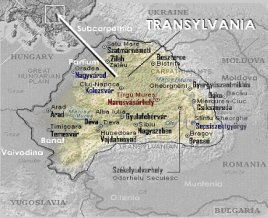 http://en.wikipedia.org/wiki/Transylvania.
The majority of Romania's ethnic Hungarians live in the Western
part of the country, in the region of Transylvania. 6,6% of
Romania's population consider themselves Hungarians (1,431.000),
which is 20% of the total population of Transylvania (census
2002). Thus the Hungarians are the major national minority of
Romania. In the Szekler Region the Hungarians make up the largest
minority. When Transylvania in 1919 was incorporated into Romania
in the Peace Treaty of Trianon the rights of the national
minority were safeguarded and Romania even granted the right to
autonomy to the Hungarian Szekler minority of Transylvania. In
1989 the Democratic Alliance of Hungarians in Romania (DAHR) was
founded, which still is the most representative force of
Romania's Hungarians. In a basic treaty signed in 1995 by Hungary
and Romania the first renounced on claims on the territory, the
latter promised to respect the rights of the Hungarian
minority.
http://en.wikipedia.org/wiki/Transylvania.
The majority of Romania's ethnic Hungarians live in the Western
part of the country, in the region of Transylvania. 6,6% of
Romania's population consider themselves Hungarians (1,431.000),
which is 20% of the total population of Transylvania (census
2002). Thus the Hungarians are the major national minority of
Romania. In the Szekler Region the Hungarians make up the largest
minority. When Transylvania in 1919 was incorporated into Romania
in the Peace Treaty of Trianon the rights of the national
minority were safeguarded and Romania even granted the right to
autonomy to the Hungarian Szekler minority of Transylvania. In
1989 the Democratic Alliance of Hungarians in Romania (DAHR) was
founded, which still is the most representative force of
Romania's Hungarians. In a basic treaty signed in 1995 by Hungary
and Romania the first renounced on claims on the territory, the
latter promised to respect the rights of the Hungarian
minority.
The DAHR joined the Romanian government after the elections of
1996, 2000 and 2004 becoming a major factor of Romania's
political life (6,8% of votes for the Chamber of Deputies, 6,9%
for the Senate). Among its major tasks remains the full respect
of the fundamental rights and freedoms of the Hungarian
community. DAHR president Bela Marko, actually as Deputy Prime
Minister responsible for education, cultural and European
integration, presented a "draft minority law" to regulate some
aspects of the right to use of mother tongue in public life and
education. The most important task of the draft is setting the
framework for cultural autonomy, while a growing number of
Hungarians associations and people are claiming a full fledged
territorial autonomy. Thus, the ethnic "Hungarian Conference in
Romania" called upon the Romanian parliament and government to
ensure full equality for the Hungarian community and to approve
the "Szekler Autonomy Statutes". The EU has been invited to the
establishment of an autonomy for Eastern Transylvania among the
accession criteria for Romania to the EU in 2007.
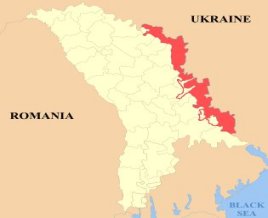 http://en.wikipedia.org/wiki/Transnistria.
Transnistria (land area: 3.567 km2, total population in 2004:
555.000) is a de-facto independent region of the Republic of
Moldova since the 2 September 1990. Beginning with Moldova's
emancipation from the Soviet Union from 1990 onwards, protest
movements against Moldova's independence started in the region
east of the Dnjestr river, predominantly inhabited by
non-Moldavians (ethnic Russians and Ukrainians).
http://en.wikipedia.org/wiki/Transnistria.
Transnistria (land area: 3.567 km2, total population in 2004:
555.000) is a de-facto independent region of the Republic of
Moldova since the 2 September 1990. Beginning with Moldova's
emancipation from the Soviet Union from 1990 onwards, protest
movements against Moldova's independence started in the region
east of the Dnjestr river, predominantly inhabited by
non-Moldavians (ethnic Russians and Ukrainians).
In June 1992 a brief war broke out, as Transnistrian
secessionists were backed by the 14th Russian army stationed in
this area since Soviet Union times. In the conflict about 1.000
people died and several 10.000 had to leave their homes. On 21
July 1992 a cease-fire agreement was signed between the Republic
of Moldova and the Russian Federation, obliging the parties to a
peaceful solution of the conflict and deploying a trilateral
Russian-Moldovan-Transnistrian peacekeeping force. The need of a
special status of the left bank of the Dnjestr and the right of
the population of this area to decide on its own future if
Moldova were to reunite with Romania has been the main issues of
contention since 1990. Negotiations on a autonomy status such as
Gagauzia's up to now were unsuccessful. Currently the OSCE is
trying to resolve the situation.
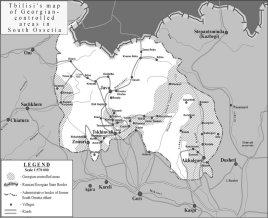 http://en.wikipedia.org/wiki/South_Ossetia.
South Ossetia covers an mountainous area of about 3.900 km2 with
about 70.000 inhabitants, in majority ethnic Ossetians. It is de
facto independent from Georgia. South Ossetia was absorbed by
Russia in 1801. In 1918 following the Russian October Revolution
the region became a part of Georgia and the Soviet Union. In the
Soviet time, under the rule of Georgia's government, it enjoyed
some degree of autonomy, including to use the Ossetian language
as official and as education language. In the aftermath of
Georgia's independence in 1991 Georgian became the only official
state language. The Ossetian minority felt sidelined and
continued to seek greater levels of autonomy, but were faced with
increasing nationalism and centralism by the government in
Tbilisi. A decision by Georgia to revoke the autonomy status of
South Ossetia in December 1990 immediately unleashed armed
insurgency leaving many villages destroyed. About 1.000 people
died and 60.000-100.000 refugees fled from the region. In 1992,
Georgia accepted a cease-fire to avoid military confrontation
with Russia. Then Georgia pledged to not impose sanctions and to
solve the question by political means. A peace keeping force of
Ossetians, Russians and Georgians was established, supported by
OSCE mission .
http://en.wikipedia.org/wiki/South_Ossetia.
South Ossetia covers an mountainous area of about 3.900 km2 with
about 70.000 inhabitants, in majority ethnic Ossetians. It is de
facto independent from Georgia. South Ossetia was absorbed by
Russia in 1801. In 1918 following the Russian October Revolution
the region became a part of Georgia and the Soviet Union. In the
Soviet time, under the rule of Georgia's government, it enjoyed
some degree of autonomy, including to use the Ossetian language
as official and as education language. In the aftermath of
Georgia's independence in 1991 Georgian became the only official
state language. The Ossetian minority felt sidelined and
continued to seek greater levels of autonomy, but were faced with
increasing nationalism and centralism by the government in
Tbilisi. A decision by Georgia to revoke the autonomy status of
South Ossetia in December 1990 immediately unleashed armed
insurgency leaving many villages destroyed. About 1.000 people
died and 60.000-100.000 refugees fled from the region. In 1992,
Georgia accepted a cease-fire to avoid military confrontation
with Russia. Then Georgia pledged to not impose sanctions and to
solve the question by political means. A peace keeping force of
Ossetians, Russians and Georgians was established, supported by
OSCE mission .
 http://en.wikipedia.org/wiki/http://en.wikipedia.org/wiki/Cabinda_%28province%29.
With an area of about 4.000 km2 the Angolan province of Cabinda
is separated from the rest of the country by a 60 km-wide strip
of territory of Congo. Cabinda has an estimated population of
600.000. Cabinda, due to its major resource oil, is considered
Africa's Kuwait. Its considerable offshore oil reserves now
accounts for more than half of Angola's output. Despite this rich
oil reserves, Cabinda has remained one of Angola's poorest
provinces. An agreement in 1996 between the national and
provincial governments stipulated that 10% of Cabinda's taxes on
oil revenues should be given back to the province, but also these
funds mostly ended up in corrupt central bureaucracy.
http://en.wikipedia.org/wiki/http://en.wikipedia.org/wiki/Cabinda_%28province%29.
With an area of about 4.000 km2 the Angolan province of Cabinda
is separated from the rest of the country by a 60 km-wide strip
of territory of Congo. Cabinda has an estimated population of
600.000. Cabinda, due to its major resource oil, is considered
Africa's Kuwait. Its considerable offshore oil reserves now
accounts for more than half of Angola's output. Despite this rich
oil reserves, Cabinda has remained one of Angola's poorest
provinces. An agreement in 1996 between the national and
provincial governments stipulated that 10% of Cabinda's taxes on
oil revenues should be given back to the province, but also these
funds mostly ended up in corrupt central bureaucracy.
Since the early 60s several movements advocating a separate
status for Cabinda came into being, the most active has been the
MLEC (Movement for the Liberation of the Enclave of Cabinda) and
the FLEC (Front for the Liberation of the Enclave of Cabinda).
Both movements failed to get international recognition for their
"government in exile". When Angola became independent in 1975
Cabinda's self-determination forces MLEC and FLEC claimed a
special status for Cabinda. In the first period a solution along
the lines of a "large autonomy" (following the model of the
autonomy of Madeira and Azores) was envisaged. In 1993 full scale
civil war erupted. The FLEC-FAC guerrillas proclaimed a "Federal
Republic of Cabinda", claiming control of 85% of Cabinda's total
area, and created a government in exile.
Luanda has made cleat that a secession of Cabinda is
unacceptable, but it is ready for negotiations with all armed
factions. Today, the whole issue is moving towards an autonomy
solution. Claims for independence are underpinned with Cabinda's
cultural and ethnic peculiarities. But Angola's ruling party
stated that cultural peculiarities was not enough for
independence as every province has specific cultural features.
Thus, Angola is considering autonomy for Cabinda in the framework
of shaping decentralisation for the whole country, which could be
not enough for the Cabindans.
 http://en.wikipedia.org/wiki/Gilgit-Baltistan.
Gilgit-Baltistan is the historical name of the huge region
(84.931 km2) between Western Himalaya and Karakorum, which today
forms the Northern part of Pakistan under the official term of
"Northern Areas". The region is inhabited by 1,1 million people,
belonging to a dozen indigenous peoples and ethnic minorities as
well as immigrants from mainland Pakistan. It came under the
dominion of the Princely State of Jammu and Kashmir in the mid of
the 19th century, whereas the Hunza kingdom in the very north of
the region resisted until 1878. After the partition of British
India in 1947 and the subsequent war on Jammu and Kashmir, on 1
November 1947 the indigenous liberation movement gained
independence, but had to seek protection under the newly
constituted state of Pakistan.
http://en.wikipedia.org/wiki/Gilgit-Baltistan.
Gilgit-Baltistan is the historical name of the huge region
(84.931 km2) between Western Himalaya and Karakorum, which today
forms the Northern part of Pakistan under the official term of
"Northern Areas". The region is inhabited by 1,1 million people,
belonging to a dozen indigenous peoples and ethnic minorities as
well as immigrants from mainland Pakistan. It came under the
dominion of the Princely State of Jammu and Kashmir in the mid of
the 19th century, whereas the Hunza kingdom in the very north of
the region resisted until 1878. After the partition of British
India in 1947 and the subsequent war on Jammu and Kashmir, on 1
November 1947 the indigenous liberation movement gained
independence, but had to seek protection under the newly
constituted state of Pakistan.
While the Western part of divided Jammu and Kashmir was declared
a "Free state" (Azad Jammu and Kashmir) with its own
constitution, parliament and government with full internal
autonomy, Gilgit-Baltistan was kept in a legal limbo, pending the
final juridical status of the formerly princely state of Jammu
and Kashmir, which is claimed by India, Pakistan and Kashmir. The
region since 1947 is directly governed by the central government
of Islamabad, has no genuine democratic representation neither a
national nor at regional level. Only a council with very limited
consultative powers has been established. Since 1990 unrest and
grievances are mounting and triggered of violent revolts and
bloody repression. Also due to immigration force and
inter-Islamic communal conflicts. An increasing number of
Gilgit-Baltistan political forces are claiming full autonomy
under Pakistan, the de-connection from the whole pending conflict
Jammu and Kashmir and self-determination.
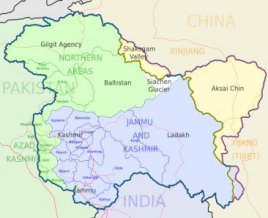 http://en.wikipedia.org/wiki/Ladakh.
The formerly princely state of Jammu and Kashmir in 1947/48,
along with the whole sub-continent, suffered partition, war and
ethnic cleansing. The Eastern part with Jammu, the Kashmir Valley
and the huge mountainous region of Ladakh was annexed to India by
the decision of its former ruler, the Maharaja. Contrary to
promises of democratic India and obligations under international
law confirmed vis-à-vis the United Nations, India never
held a popular referendum on the status of the region. Hence,
three further wars were fought by India and Pakistan, and Jammu
and Kashmir is still at the heart of bitter territorial dispute.
Jammu and Kashmir as a federated state of the Indian Union
enjoyed special autonomy status under Art. 370 of the Indian
constitution until 1953 (formally this article is still in
force).
http://en.wikipedia.org/wiki/Ladakh.
The formerly princely state of Jammu and Kashmir in 1947/48,
along with the whole sub-continent, suffered partition, war and
ethnic cleansing. The Eastern part with Jammu, the Kashmir Valley
and the huge mountainous region of Ladakh was annexed to India by
the decision of its former ruler, the Maharaja. Contrary to
promises of democratic India and obligations under international
law confirmed vis-à-vis the United Nations, India never
held a popular referendum on the status of the region. Hence,
three further wars were fought by India and Pakistan, and Jammu
and Kashmir is still at the heart of bitter territorial dispute.
Jammu and Kashmir as a federated state of the Indian Union
enjoyed special autonomy status under Art. 370 of the Indian
constitution until 1953 (formally this article is still in
force).
Since January 1990 Jammu and Kashmir are suffering first a
popular insurgency, followed by a protracted guerrilla war, which
India tries to suppress with enormous military commitment. The
war provoked at least 80.000 victims, scores of refugees and a
deep political alienation of the majority of the Muslim
population of the Kashmir valley. Long lasting talks between
Indian and Pakistan did not produce any result regarding the
political issue, the platform of Hurriyat, boycotting every kind
of elections in the state and for the Union institutions, is
advocating a referendum with at least three options: accession to
Pakistan, status quo with J&K remaining under India and
independence. The whole process is complicated by the
ethnic-religious composition of the state: in Jammu the majority
population is Hindu, in Ladakh the majority is Buddhist and
nearly all inhabitants of the Kashmir valley are Muslim. Both
Ladakh and Jammu are claiming more autonomy inside the state of
J&K or even separation, but strictly sticking to permanence
with India. Jammu and Kashmir is the only federated state of
India with a Muslim majority. A restoration of the former
autonomy under Art. 370 with elements of condominium regarding
security and external representation with Pakistan appears the
only feasible way for an interim solution.
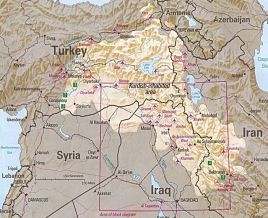 http://en.wikipedia.org/wiki/Kurdistan.
Turkish-Kurdistan is an unofficial name for the South Eastern
part of Turkey predominantly inhabited by ethnic Kurds, one
larger part of the geographical and cultural area known as
Kurdistan. The Kurds and Kurdistan not only are not officially
recognised as distinct people by Turkey, but still many Turkish
institutions deny its very existence, defining the region just
"Anatolia" and its inhabitants "mountain Turks". The Kurdish
population is spread over an area of 18 provinces of Turkey
covering 209.000 km2, but have also migrated in millions to the
large cities in the western part. The century old Kurdish
ambition for statehood was to be fulfilled in the 1920 Treaty of
Sèvres, when a truncated Kurdistan (leaving all the Kurds
of Iran, Iraq and Syria outside) was granted national rights. But
in the subsequent 1923 Treaty of Lausanne Turkish-Kurdistan was
fully recognised as an integral part of Turkey with vague
promises of autonomy.
http://en.wikipedia.org/wiki/Kurdistan.
Turkish-Kurdistan is an unofficial name for the South Eastern
part of Turkey predominantly inhabited by ethnic Kurds, one
larger part of the geographical and cultural area known as
Kurdistan. The Kurds and Kurdistan not only are not officially
recognised as distinct people by Turkey, but still many Turkish
institutions deny its very existence, defining the region just
"Anatolia" and its inhabitants "mountain Turks". The Kurdish
population is spread over an area of 18 provinces of Turkey
covering 209.000 km2, but have also migrated in millions to the
large cities in the western part. The century old Kurdish
ambition for statehood was to be fulfilled in the 1920 Treaty of
Sèvres, when a truncated Kurdistan (leaving all the Kurds
of Iran, Iraq and Syria outside) was granted national rights. But
in the subsequent 1923 Treaty of Lausanne Turkish-Kurdistan was
fully recognised as an integral part of Turkey with vague
promises of autonomy.
Ever since then Kurdish nationalists sought to obtain fundamental
collective cultural and political rights or outright
self-determination, opposing the repressive centralist policy of
the Turkish state, inspired by Kemal Atatürk. As a result,
the Southeast of Turkey has been at the centre of a long running
insurgency by the Kurdish Workers party PKK, in which more than
30.000 lives were lost, more than 2.000 Kurdish villages were
destroyed, and for decades the Kurdish provinces were transformed
in human right emergency areas. The Turkish authorities have
often been criticised by foreign governments, human rights
organisations and international organisations such as the EU, the
Council of Europe and the OSCE for their conduct in the region.
The issue has recently (2005) been reignited and remains a major
sticking point in the proposed accession of Turkey to the
European Union.
The region is still heavily militarised by the Turkish security
forces due to the activities of Kurdish resistance movement and
the unstable nature of the border (Iraq conflict. Territorial
Autonomy in this extremely centralist state with nationalist
ideology enshrined in the constitution seems still far away,
although the Kurds today in culture, education and media enjoy a
little more freedom.
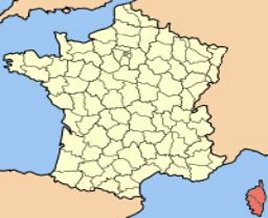 http://en.wikipedia.org/wiki/Corsica.
Corsica is the fourth largest island in the Mediterranean Sea
after Sicily, Sardinia and Cyprus, located north to Sardinia. In
France Corsica is referred to as a "region", one of the 26
regions of France, although officially it is defined a
"territorial collectivity", which enjoys slightly more powers
than other French regions. Unlike other "overseas territories of
France" in the Caribbean, in South America (Guyana) and in
Oceania Corsica is considered a part of the French
mainland.
http://en.wikipedia.org/wiki/Corsica.
Corsica is the fourth largest island in the Mediterranean Sea
after Sicily, Sardinia and Cyprus, located north to Sardinia. In
France Corsica is referred to as a "region", one of the 26
regions of France, although officially it is defined a
"territorial collectivity", which enjoys slightly more powers
than other French regions. Unlike other "overseas territories of
France" in the Caribbean, in South America (Guyana) and in
Oceania Corsica is considered a part of the French
mainland.
Corsica's claim for autonomy is based on both historical and
cultural-linguistic reasons. In 1982 96% of the island's
inhabitants of Corsican origins (just 70% of the total
population) understood and 86% regularly spoke the Corsican
language, a form of medieval Italian related with the Sardinian
language. Corsican still now is not an obligatory medium language
in schools, but can be offered as an optional subject. As
Corsican has no official status, its administrative and legal
role is minimal. It can be used occasionally in contacts with the
public administration and in court, as long as the officials
themselves know the language. But it is in no way a requirement
to have access for public employment.
There are several movements on the island calling for a real
autonomy of Corsica from France or even full independence.
Autonomy proposals focus on the promotion of the Corsican
language, more powers for an autonomous Corsican region and full
financial autonomy. While among the island's population there is
some support for a special autonomy, polls show that a large
majority of Corsicans are opposed to full independence. Some
nationalist Corsican groups carried out violent campaigns since
the 70ies, including bombings and assassinations, usually
targeting officials and buildings representing the French
government. France responded also to peaceful protest with an
overwhelming force, generating sympathy for the independence
groups among the Corsican population. In 2000, the French Prime
Minister Jospin agreed increased autonomy to Corsica in exchange
for an end to violence. The proposed autonomy for Corsica would
have included greater protection for the Corsican language, whose
practice like other minority languages in France, had been
discouraged. According to UNESCO classification, the Corsican
language is currently in danger of becoming extinct.
However, the plans for increased autonomy were opposed by the
Gaullist opposition in the French National assembly, who feared
that this would lead to calls for autonomy from other regions
such as Brittany, the Basque Country and Alsace. eventually
threatening France's unity. In a referendum on 6 July 2003 a
narrow majority of Corsican voters opposed a project of the Paris
government to grant a major autonomy to the territorial
collectivity of Corsica. As the 2003 referendum shows, still
broad sectors of Corsica's population do not wish more autonomy.
Nevertheless Corsica's example by some other regional minorities
in France has been taken as an encouragement to claim autonomy as
well (Alsace, Brittany, Savoy, the Basque Country) and also in
the French Overseas Departments Martinique, Guadeloupe and
Guyana.
The cultural region of Brittany - a peninsula in Northwestern
France once a independent kingdom and duchy - today is split
between the region of Bretagne and some parts attached to
neighboring departements and regions of France. The land area of
this cultural region is 34.034 km2 with a population of about 4,2
million. The duchy of Brittany kept specific laws and taxes until
1790, when French revolutionaries withdrew all the "privileges".
French today is the only official language and spoken throughout
Brittany, while the two regional Breton and Gallo languages have
no official status, although they are supported by regional
authorities within the strict national laws. Until the 1960s
Breton still was spoken and understood by the majority of
Brittany population. Now the Breton language and culture is
living a strong revival as other Celtic cultures (in Galicia,
Ireland, Wales and Scotland), supported by a private education
network called Diwan. Regionalist parties, advocating territorial
autonomy, are gaining ground, but are far away from being
majorities.
 http://en.wikipedia.org/wiki/Chiapas.
On the 1 January 1994 the Zapatista Liberation Front (Ejercito
Zapatista de Liberación Nacional) occupied a part of the
Mexican state of Chiapas, overwhelmingly inhabited by indigenous
peoples, claiming cultural autonomy, land rights, democratic
participation and resistance against the neo-liberal strategies
of the Mexican government. The same day Mexico had officially
joined the North American Free Trade Association (NAFTA). The
Zapatista movement was a shining signal for militant commitment
and popular movement for indigenous rights and social rights not
only in Chiapas, but in many other parts of Latin America. The
Mexican government tried to repress the movement with all means,
including military occupation and aggression.
http://en.wikipedia.org/wiki/Chiapas.
On the 1 January 1994 the Zapatista Liberation Front (Ejercito
Zapatista de Liberación Nacional) occupied a part of the
Mexican state of Chiapas, overwhelmingly inhabited by indigenous
peoples, claiming cultural autonomy, land rights, democratic
participation and resistance against the neo-liberal strategies
of the Mexican government. The same day Mexico had officially
joined the North American Free Trade Association (NAFTA). The
Zapatista movement was a shining signal for militant commitment
and popular movement for indigenous rights and social rights not
only in Chiapas, but in many other parts of Latin America. The
Mexican government tried to repress the movement with all means,
including military occupation and aggression.
In August 2003 five regions under control of Zapatistas and
hundreds of municipalities inhabited by some 300.000 people,
gathered to form an unofficial "autonomous Zapatista region". The
EZLN, which since 1994 has not carried out any new military
operations, considered this step as a logical consequence of the
treaty with Mexico of San Andrés referring to cultural
autonomy and indigenous rights. The municipalities, mostly very
poor and economically backward, declared autonomy and established
structures of democratic self-governance. The five regions by the
Zapatista movement of Chiapas are called "caracoles" (shells).
The self-governed communities tried to set up an autonomous
health assistance, school system, trade network and productive
activities in co-operatives. But the core of the autonomy claim
remains the cultural distinctiveness, inspired by indigenous
languages, community life, religious beliefs, values. Whereas
female participation is moving around 33% of the political
representatives in the new communities, it is still considered as
not sufficient.
According to EZLN statements, the Zapatista movement is not
questioning the sovereignty of Mexico in Chiapas. Autonomy by the
EZLN is seen as a device to achieve two major aims for the
indigenas: equality as Mexican citizens, which means an end of
social and economic discrimination of the indigenous and poor
small farmers and the right to diversity, which is means full
recognition of the ethnic-cultural peculiarity of the indigenous
peoples (20% of Chiapas' population of totally 4 million are
belonging to about 10 indigenous peoples). The "Autonomous
Zapatista Region in Chiapas", despite being de facto autonomous,
could not be considered in this text as a "territorial autonomy"
as it is not recognised by the Mexican state as a de jure
arrangement and thus not corresponding to the criteria of a
official regional autonomy as outlined under chapter 2.2 and
2.10.
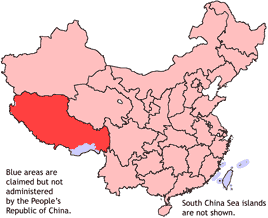 http://en.wikipedia.org/wiki/Tibet.
Until 1949 the entire territory of Tibet (about 2,5 million km2)
was governed by an independent Tibetan government under the
leadership of the Dalai Lama. After the invasion of the Chinese
Red Army in eastern Tibet in 1949, China's revolutionary regime
forced the Tibetan rulers to sign the "17-points-peace-agreement"
in 1951. Subsequently the People's Republic of China maintained
that Tibet was an inalienable part of the PRC. In 1959, after an
unsuccessful revolt, the Tibetan leadership under the Dalai Lama
fled to India and more than 100.000 Tibetans took refuge in South
Asian countries, Europe and North America. Today the major part
of the historical Tibet is governed as an Autonomous Region which
has been created as the fifth and last of China's so-called
"Autonomous Regions" in 1965 The TAR refers only to the central
province of U Tsang, while large parts of Amdo and Kham are
incorporated in the neighbouring province of Qinghai and Yunnan.
While the PRC claims to permit the TAR a substantial measure of
self-government, in reality, the core authority rests almost
entirely with the Central Government and the Communist Party of
China.
http://en.wikipedia.org/wiki/Tibet.
Until 1949 the entire territory of Tibet (about 2,5 million km2)
was governed by an independent Tibetan government under the
leadership of the Dalai Lama. After the invasion of the Chinese
Red Army in eastern Tibet in 1949, China's revolutionary regime
forced the Tibetan rulers to sign the "17-points-peace-agreement"
in 1951. Subsequently the People's Republic of China maintained
that Tibet was an inalienable part of the PRC. In 1959, after an
unsuccessful revolt, the Tibetan leadership under the Dalai Lama
fled to India and more than 100.000 Tibetans took refuge in South
Asian countries, Europe and North America. Today the major part
of the historical Tibet is governed as an Autonomous Region which
has been created as the fifth and last of China's so-called
"Autonomous Regions" in 1965 The TAR refers only to the central
province of U Tsang, while large parts of Amdo and Kham are
incorporated in the neighbouring province of Qinghai and Yunnan.
While the PRC claims to permit the TAR a substantial measure of
self-government, in reality, the core authority rests almost
entirely with the Central Government and the Communist Party of
China.
Provisions allegedly intended to promote autonomy in the TAR have
almost invariably failed to grant Tibetans residing in the TAR
meaningful self-rule. It is very questionable whether the
Tibetans are allowed to enjoy their fundamental cultural rights
under the Chinese Law on National Regional Autonomy of 1984.
Although the TAR, especially since the end of the Mao era in the
80s, has undergone "modernisation" in terms of economy,
infrastructure, public services, administration, health and
education system, the still serious record of human rights
abuses, the lack of religious and political freedoms, the
discrimination in the economic development is threatening the
Tibetans.
The Tibetan government in exile (Dharamsala, India), since the
Dalai Lama's Strasbourg proposal in the European Parliament of 15
June 1988, has proposed to establish a genuine autonomy for the
whole territory of historical Tibet under the sovereignty of
China which would keep the power on foreign affairs and defence.
Since the transfer of sovereignty over Hong Kong in 1997 from UK
to China under the motto "one country, two systems", Tibetan
representatives in exile have repeatedly claimed the application
of the same principle for Tibet in the framework of the Chinese
Constitution. While the proposal has been rejected by Bejing, it
should be noted that an autonomy in Hong Kong style could not
meet the minimum standard of modern genuine autonomy.
Regional autonomy not only can potentially cater for most of
the needs and interests of national minorities, but its decisive
advantage that it does not clash with the interest of the states
to preserve full integrity of their territory. Autonomy in
addition must often tackle a double problem: to grant the
protection of the national minority in its traditional homeland,
but also to include self-governance all the groups living in that
area. Regional autonomy, as the label suggests, should benefit a
whole regional community, not just one sector of the regional
population.
But regional autonomy - in order to be an enduring solution - has
to be built on solid legal foundations: a pure domestic or
internal entrenchment of an autonomy arrangement in several cases
might be too weak to grant its acceptance by the concerned
national minorities. In this regard Kosovo's experience is a
striking example: the escalation of the conflict was mainly due
to the abolition of the autonomy of this Serbian province in
1989, which had been established by Tito only in 1974. But
regional autonomy was the minimum what former Yugoslavia could
have offered to Kosovo's Albanians, by number more than
Macedonians, Slovenes and Montenegrins., considering that in 1945
Kosovo has been denied the status of a federal republic.
But this autonomy, not based on any agreement with Albania, has
been cancelled by Milosevic along with the autonomy of Vojvodina,
depriving the Albanians from any protection of Serbian
chauvinism, has not been the first case of "lost autonomies":
other precedents are Jammu and Kashmir in the 1950ies, with an
autonomy curtailed by federal India under Nehru, Eritrea which
enjoyed autonomy under Ethiopia from 1962 to 1972 and South Sudan
(1972-1983), finally the short autonomy experience of Iraqi
Kurdistan smashed by Saddam Hussein in 1977. All those cases lead
to war and genocide for so many years, South Sudan's agony lasted
19 years claiming more than 2 million lives, whereas the conflict
in Kashmir is still going on. In the 90ies, Abkhazia and South
Ossetia, former autonomous regions of Georgia, rebelled against
the abolition of their autonomy by independent Georgia, declaring
themselves independent as well. In all those cases the
International Community did not intervene as autonomy was
considered a purely internal arrangement, lacking any
international entrenchment.
Generally, regionally autonomies - there are about 60 within 21
states all over the world, if counting only systems operating in
democratic states with full rule of law - are established as
solutions of compromise between the claim of self-determination
of a smaller people and the interest of a central state to
preserve its integrity. Relying on such a compromise for a
national minority cannot be based only on confidence and good
will and a simple state law, but requires strong guarantees
enshrined in the country's constitution or even better in a
bilateral or international agreement. But just a tiny part of the
world's operating autonomous regions can count on such an
entrenchment, for instance the autonomous province of South
Tyrol, Italy.
But this is a key requirement of integrating the legal system of
minority protection and the collective rights of peoples, if the
case of Kosovo is not be referred to a precedent for any
secessionist movement. The Federal Union of Europe Nationalities
already in 1994 submitted to the Council of Europe a "Draft
European Convention on the Right to Autonomy", which
unfortunately has not been discussed so far. But from the case of
Kosovo we can draw the lesson that autonomies which are curtailed
or even abolished, are a major risk not only for the population
who suffer its immediate effects, but also for peace and
stability in the whole region. Without having a perspective of a
far reaching and safe autonomy possibly entrenched in
international law, secessionist forces ever will find some good
arguments to invoke independence as the only way out.
As aforementioned in many open conflicts territorial autonomy could offer a political and legal device, combining minority protection with internal self-determination without changing state boundaries. In most of the working regional autonomy systems in at least 21 states of the world such an arrangement of power sharing is meeting acceptance by both, the regional community and the central states. The potential of regional autonomy as a means of conflict solution and minority protection is far from being exhausted. Secession can hardly be legitimised if a smaller people or national minority enjoys the whole range of minority rights and even a large degree of territorial autonomy. Elaborating, discussing and adopting an "international covenant on the right to autonomy", which could define precisely under which circumstances the right to internal and external self-determination should be recognized and autonomy should be accorded, can definitely be helpful to bring about a positive solution for many ongoing ethnic conflicts.
Thomas Benedikter, Political and
social researcher based in Bozen (South Tyrol, Italy),
collaborating with the European Academy of Bozen/Bolzano. Among
his last publications: "The World's Working Regional Autonomies"
(ANTHEM, New Delhi 2007), "Krieg im Himalaya" (LIT Berlin 2003),
"Il groviglio del Kashmir" (Frilli, Genoa 2005). "The
World's Working Regional Autonomies - An Introduction and
Comparative Analysis"
Editor: Anthem Press, London/New Delhi
ISBN: 978 1 84331 730 2
Pages: 496
Price: 30.- Pound (in India: 695.- RS).
Summing up the key editorial points of this volume, three are in
the focus: first, an innovative theoretical approach to regional
political autonomy aimed to elaborate the basic criteria and
quality standards which a true modern territorial autonomy has to
meet; second, a schematic, but for the given purpose sufficient
presentation of the key aspects of all regional autonomies; and
third, a comparative analysis based on ten fundamental functions
of a political autonomy. This kind of analysis forms a
precondition for an evaluation of the real, historical
performance of the given autonomy systems. The author's approach
to this complex issue opens up a new perspective on political
autonomy as a world-wide applicable tool of preserving the
fundamental rights and interests of ethnic minorities without
questioning the state's given national integrity. The work
certainly fills a niche in the current publications on
territorial autonomy where such comprehensive and comparative
analysis is not yet available. The publication can be considered
a contribution to research efforts aimed to gain a realistic
insight in what political autonomy can produce, but also on its
limits, preventing unmotivated expectations from both sides
involved in typical conflicts of self-government on a regional
level. As the author stresses, regional autonomy is no recipe for
all times and all places, but if the international community is
going to recognise the efficiency and necessity of this formula
it might achieve a major role in the efforts of peaceful solution
of ethnic conflicts.
Anthem Press, 75-76 Blackfriars Road, London SE1 8HA - United
Kingdom. Email: sales@anthempress.com